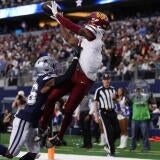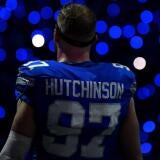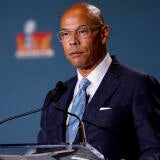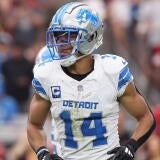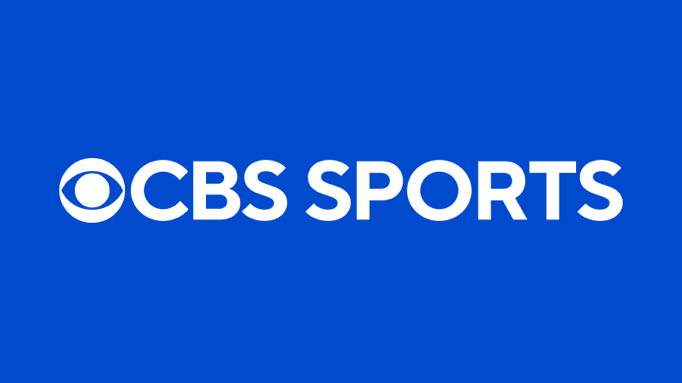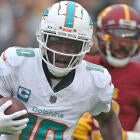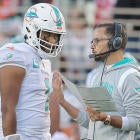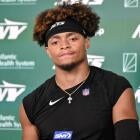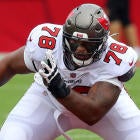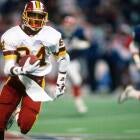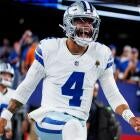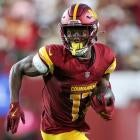2025 NFL Draft: What the Giants, Bears and other teams with most draft pick value were able to accomplish
Did these clubs do enough?
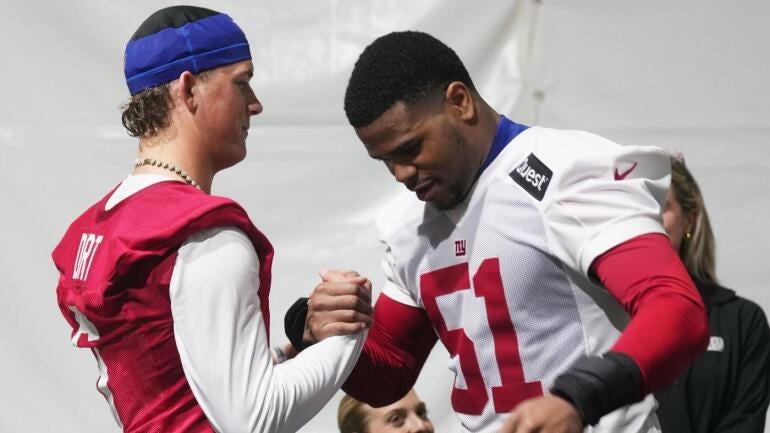
NFL teams go into the draft with varying levels of resources -- often based upon their win-loss record from the prior season. Those resources do not guarantee a successful draft but, in theory, should increase the odds. Teams with more draft capital should have the flexibility to make the moves that best serve the interests of the organization.
In the lead up to the 2025 NFL Draft, I ranked each of the league's teams based on the value of its draft picks. In the aftermath of the three-day event, we explore what teams were able to accomplish with that draft pick value.
10. Carolina Panthers
(Pre-draft: 639.81 points; post-draft: 634.39)
- Round 1, pick 8: WR Tetairoa McMillan, Arizona
- Round 2, pick 51: EDGE Nic Scourton, Texas A&M
- Round 3, pick 77: EDGE Princely Umanmielen, Ole Miss
- Round 4, pick 114: RB Trevor Etienne, Georgia
- Round 4, pick 122: S Lathan Ransom, Ohio State
- Round 5, pick 140: DT Cam Jackson, Florida
- Round 5, pick 163: TE Mitchell Evans, Notre Dame
- Round 6, pick 208: WR Jimmy Horn Jr., Colorado
Carolina found a nice marriage between value and needs in this draft class. Arizona wide receiver Tetairoa McMillan gives Bryce Young a big outlet who can be a building block to the future. Edge rushers Nic Scourton and Princely Umanmielen fulfill big-time needs. The Panthers spent half of their draft picks on skill positions like wide receiver, tight end and running back. The team made a few small trades to move around and target a few players.
9. New Orleans Saints
(Pre-draft: 668.44 points; post-draft: 668.44)
- Round 1, pick 9: OT Kelvin Banks Jr., Texas
- Round 2, pick 40: QB Tyler Shough, Louisville
- Round 3, pick 71: DT Vernon Broughton, Texas
- Round 3, pick 93: S Jonas Sanker, Virginia
- Round 4, pick 112: LB Danny Stutsman, Oklahoma
- Round 4, pick 131: CB Quincy Riley, Louisville
- Round 7, pick 248: TE Moliki Matavao, UCLA
- Round 7, pick 254: EDGE Fadil Diggs, Syracuse
New Orleans has used five of its past nine first-round draft picks on offensive linemen, including Texas' Kelvin Banks Jr. in this year's edition. The Saints then addressed the quarterback position in the second round (Louisville's Tyler Shough). The future of Derek Carr is now more clear (he's retiring) after being speculated upon for the past month-plus. Shough gives them an option capable of starting Week 1 rather than a developmental prospect like Jalen Milroe.
The franchise atoned for its neglect of the defense by using five of its remaining seven selections on that side of the ball, including Texas defensive tackle Vernon Broughton and Virginia safety Jonas Sanker in the top-100 overall. It was the only team on this list to make every one of its scheduled picks.
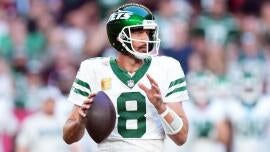
8. New York Jets
(Pre-draft: 683.0 points; post-draft: 684.70)
- Round 1, pick 7: OT Armand Membou, Missouri
- Round 2, pick 42: TE Mason Taylor, LSU
- Round 3, pick 73: CB Azareye'h Thomas, Florida State
- Round 4, pick 110: WR Arian Smith, Georgia
- Round 4, pick 130: S Malachi Moore, Alabama
- Round 5, pick 162: LB Francisco Mauigoa, Miami
- Round 5, pick 176: EDGE Tyler Baron, Miami
The Jets had long been associated with quarterback prospects in this class, but did not use any of its seven choices on the position. Defensive-minded head coach Aaron Glenn's first draft was defined by three of its first four selections being used on the offense: Missouri offensive tackle Armand Membou, tight end Mason Taylor and Georgia wide receiver Arian Smith. Florida State cornerback Azareye'h Thomas, a potential replacement for D.J. Reed, was taken in the third round to break up the commitment to offense.
7. Chicago Bears
(Pre-draft: 711.72 points; post-draft: 701.70)
- Round 1, pick 10: TE Colston Loveland, Michigan
- Round 2, pick 39: WR Luther Burden III, Missouri
- Round 2, pick 56: OT Ozzy Trapilo, Boston College
- Round 2, pick 62: DT Shemar Turner, Texas A&M
- Round 4, pick 132: LB Ruben Hyppolite II, Maryland
- Round 5, pick 169: CB Zah Frazier, Texas-San Antonio
- Round 6, pick 195: OG Luke Newman, Michigan State
- Round 7, pick 233: RB Kyle Monangai, Rutgers
Chicago stayed true to its board and took prospects who were not often associated with them rather than reaching to fill positions of need, such as running back, edge rusher, etc. The Bears may lean into more 12 personnel (one running back, two tight ends) upon inspecting the wide receiver and tight end units. There was an emphasis on athleticism through the additions of Michigan tight end Colston Loveland, Missouri wide receiver Luther Burden III, Texas A&M defensive tackle Shemar Turner and others.
6. Las Vegas Raiders
(Pre-draft: 740.06 points; post-draft: 746.93)
- Round 1, pick 6: RB Ashton Jeanty, Boise State
- Round 2, pick 58: WR Jack Bech, TCU
- Round 3, pick 68: CB Darien Porter, Iowa State
- Round 3, pick 98: OG Caleb Rogers, Texas Tech
- Round 3, pick 99: OT Charles Grant, William & Mary
- Round 4, pick 108: WR Dont'e Thornton Jr., Tennessee
- Round 4, pick 135: DT Tonka Hemingway, South Carolina
- Round 6, pick 180: DT JJ Pegues, Ole Miss
- Round 6, pick 213: WR Tommy Mellott, Montana State
- Round 6, pick 215: QB Cam Miller, North Dakota State
- Round 6, pick 222: LB Cody Lindenberg, Minnesota
It was a Pete Carroll draft meshed with a Mark Davis draft. A desire to field a strong run game gave way to the long, fast, traits-y prospects who have often been associated with the organization. Iowa State cornerback Darien Porter, TCU wide receiver Jack Bech and Tennessee wide receiver Dont'e Thornton Jr. all fulfill positions of need for the organization.
5. Jacksonville Jaguars
(Pre-draft: 840.14 points; post-draft: 923.98)
- Round 1, pick 2: WR/CB Travis Hunter Jr., Colorado
- Round 3, pick 88: CB Caleb Ransaw, Tulane
- Round 3, pick 89: OG Wyatt Milum, West Virginia
- Round 4, pick 104: RB Bhayshul Tuten, Virginia Tech
- Round 4, pick 107: LB Jack Kiser, Notre Dame
- Round 6, pick 194: LB Jalen McLeod, Auburn
- Round 6, pick 200: S Rayuan Lane III, Navy
- Round 7, pick 221: C Jonah Monheim, USC
- Round 7, pick 236: RB LeQuint Allen, Syracuse
Jacksonville obviously sacrificed some of its future resources for current objectives. By moving up three spots for the right to select Colorado two-stay star Travis Hunter, the Jaguars parted with a future first-round pick. Hunter is a talent capable of allowing the offense to take big leaps forward in Year 1 under the direction of new head coach Liam Coen.
They did a good job picking other likely contributors along the way, including Tulane cornerback Caleb Ransaw, West Virginia offensive guard Wyatt Milum and Virginia Tech running back Bhayshul Tuten. It is clear they put an emphasis on toughness and accountability in this draft class.
4. New England Patriots
(Pre-draft: 883.21 points; post-draft: 878.99)
- Round 1, pick 4: OT Will Campbell, LSU
- Round 2, pick 38: RB TreVeyon Henderson, Ohio State
- Round 3, pick 69: WR Kyle Williams, Washington State
- Round 3, pick 95: C Jared Wilson, Georgia
- Round 4, pick 106: S Craig Woodson, California
- Round 4, pick 137: DT Joshua Farmer, Florida State
- Round 5, pick 146: EDGE Bradyn Swinson, LSU
- Round 6, pick 182: K Andres Borregales, Miami
- Round 7, pick 220: OT Marcus Bryant, Missouri
- Round 7, pick 251: LS Julian Ashby, Vanderbilt
- Round 7, pick 257: CB Kobee Minor, Memphis
New England made some small moves around in the draft, but nothing of consequence. The first four picks were used on the offense whereas four of the last seven picks addressed the defense. Left tackle was a critical need, and the Patriots left little to chance by taking LSU's Will Campbell No. 4 overall. One quality shared among the majority of the draft class is a history of production. They added known high IQ football players who could come in and contribute immediately.
3. New York Giants
(Pre-draft: 958.63 points; post-draft: 972.95)
- Round 1, pick 3: EDGE Abdul Carter, Penn State
- Round 1, pick 25: QB Jaxson Dart, Ole Miss
- Round 3, pick 65: DT Darius Alexander, Toledo
- Round 4, pick 105: RB Cam Skattebo, Arizona State
- Round 5, pick 154: OT Marcus Mbow, Purdue
- Round 7, pick 219: TE Thomas Fidone II, Nebraska
- Round 7, pick 246: CB Korie Black, Oklahoma State
The Giants executed their draft plan to perfection, although only time will tell if those were the correct strategic moves. As expected, they selected Penn State pass rusher Abdul Carter No. 3 overall, but one of the biggest moves made in the first round involved New York moving back in for Ole Miss quarterback Jaxson Dart. Although it added value in 2025, it did cost them a future third-round selection -- a small price to pay if the quarterback works out. With the other selections, the Giants mostly targeted role players like Toledo's Darius Alexander and Arizona State running back Cam Skattebo.
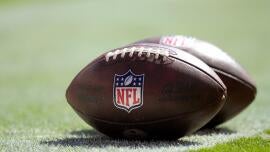
2. Cleveland Browns
(Pre-draft: 1,086.83 points; post-draft: 960.71)
- Round 1, pick 5: DT Mason Graham, Michigan
- Round 2, pick 33: LB Carson Schwesinger, UCLA
- Round 2, pick 36: RB Quinshon Judkins, Ohio State
- Round 3, pick 67: DT Harold Fannin Jr., Bowling Green
- Round 3, pick 94: QB Dillon Gabriel, Oregon
- Round 4, pick 126: RB Dylan Sampson, Tennessee
- Round 5, pick 144: QB Shedeur Sanders, Colorado
Cleveland was a part of the biggest splash of the evening, moving back from No. 2 overall to No. 5 overall. In the process, it picked up Michigan defensive tackle Mason Graham, Ohio State running back Quinshon Judkins and a 2026 first-round selection. The Browns pushed all of their chips to the middle of the table after acquiring quarterback Deshaun Watson. A lack of contributions from Watson, as well as the loss of draft resources, depleted the roster, so the trade back to acquire additional draft picks was the first acknowledgement of a soft rebuild.
In addition to Graham, the Browns double-dipped at both running back (Tennessee's Dylan Sampson and Judkins) and quarterback (Oregon's Dillon Gabriel and Colorado's Shedeur Sanders). If Cleveland can get starting production out of either quarterback, then excess value will have been attained. No selection of a wide receiver and the addition of Bowling Green tight end Harold Fannin Jr. suggest that head coach Kevin Stefanski is returning to his roots of utilizing more 12 personnel (one running back, two tight ends).
1. Tennessee Titans
(Pre-draft: 1,129.21 points; post-draft: 1,125.44)
- Round 1, pick 1: QB Cam Ward, Miami
- Round 2, pick 52: EDGE Oluwafemi Oladejo, UCLA
- Round 3, pick 82: S Kevin Winston Jr., Penn State
- Round 4, pick 103: WR Chimere Dike, Florida
- Round 4, pick 120: TE Gunnar Helm, Texas
- Round 4, pick 136: WR Elic Ayomanor, Stanford
- Round 5, pick 167: OG Jackson Slater, Sacramento State
- Round 6, pick 183: CB Marcus Harris, California
- Round 6, pick 188: RB Kalel Mullings, Michigan
Tennessee's draft will be defined by No. 1 overall pick Cam Ward. The rest of the draft left a lot to be desired. Nothing jumps off the page in terms of dynamic, immediate contributors. The Titans did a lot of work in free agency to supplement the offensive line, so the hope now is that the three pass-catchers taken in the fourth round (Florida wide receiver Chimere Dike, Texas tight end Gunnar Helm and Stanford wide receiver Elic Ayomanor) will rise to the occasion and provide production alongside wide receiver Calvin Ridley. The team made negligible moves to impact its overall point value, however.
![[object Object] Logo](https://sportshub.cbsistatic.com/i/2020/04/22/e9ceb731-8b3f-4c60-98fe-090ab66a2997/screen-shot-2020-04-22-at-11-04-56-am.png)












